








































































































Auto catalyst recycling has seen a substantial decline, with volumes down by approximately 30% or more from their peak in 2019. The trends in the auto catalyst recycling market and platinum group metal (PGM) prices are driven by a complex interplay of economic conditions, supply chain dynamics, industry-specific changes, speculative activities, and geopolitical risks. These factors are interconnected, with changes in one area often having cascading effects on others. Understanding these relationships is crucial for predicting future trends in PGM markets and the recycling industry.
RECYCLING VOLUMES DOWN. Daniel Croft, Commodity Analyst, for UK-based metals consultancy, SFA (Oxford), stated that, “Platinum-group metals’ (PGMs) open-loop recycling is estimated to have grown from ~500 koz. in the mid-1990s and less than 1 moz. in 2000 to 4.21 moz. forecast for 2024 in 3E PGM terms. From 2000 to 2019, PGM recycling grew by an average of 9% p.a., peaking at just below 5 moz. just as the Coronavirus began to spread around the globe.”
Auto catalyst recycling volumes have declined by around 30% from their peak levels, mainly due to consumers holding onto vehicles longer amid economic

uncertainty, which has reduced the availability of end-of-life vehicles (ELVs) for recycling. Additionally, the global semiconductor shortage disrupted automotive production, further limiting the flow of older vehicles to scrapyards. Lower PGM prices have also made recycling less economically viable, leading to decreased activity and hoarding of spent catalytic converters by recyclers. PGM PRICES DOWN. Platinum peaked in 2008, at $2,200/toz., now down 58% to $900/toz.; Palladium peaked in 2020, at $3,000/toz., now down 68% to $950/toz;
Auto catalyst
recycling
volumes have declined by around 30% from their
peak
levels, mainly due to consumers holding onto vehicles longer amid economic uncertainty, which has reduced the availability of end-of-life vehicles (ELVs)
for recycling.
and Rhodium peaked in 2021, at $29,000/ toz., now down 85% to $4,520/toz.
The factors affecting PGM prices are multifaceted. Global economic conditions, including inflation and rising interest rates, impact investor demand and the opportunity cost of holding PGMs. Supply chain disruptions, particularly in regions like South Africa and Russia, where PGM production is concentrated, can lead to supply constraints and price spikes. The automotive industry’s shift towards electric vehicles (EVs) and hybrids affects long-term PGM demand, although hybrid production still supports demand in the short term. Speculative trading in the futures market, especially in palladium, adds volatility, with large short positions creating the potential for short-covering rallies. Investment demand for PGMs as a hedge against economic uncertainty can also drive prices higher, while geopolitical risks, such as sanctions or political instability, further contribute to price fluctuations. Technological advancements in emissions control systems and government policies enforcing stricter emissions regulations also play crucial roles in shaping PGM demand and prices.
IMPACT OF COVID-19. The pandemic caused a significant drop in vehicle production, which has yet to fully recover.
Becky Berube has served the recycling community for over thirty years. Based in Greenville, South Carolina as President of United Catalyst Corporation, she writes a monthly educational column for the industry, and serves on several ARA and ReMa committees. She is a newly appointed Advisor on the US Industry Trade Advisory Committee on Critical Minerals. She was a recipient of a 2023 South Carolina Women in Business Award and is a mentor in the Women in PGMs program. Additionally, Becky serves as an At-Large Director of the ReMa Southeast Board, Co-Chair of the IPMI Preventing Auto Catalyst Theft Committee, and is on the Board of Directors of the International Precious Metals Institute (IPMI), where she is a past President.





This has affected both the supply of end-of-life vehicles for recycling and the demand for new vehicles with catalytic converters.
PGM MARKET OUTLOOK. The platinum market has shifted into a structural deficit due to flat primary supply, recovering demand, and lower recycling rates. Palladium and rhodium markets face similar supply challenges, with potential shortfalls expected in 2024.
Of note, in speaking with SFA (Oxford) they commented that, “As an observation, one area that everyone is getting blind-sided by is why do all forecasters have deficits and palladium prices aren’t rising. It is worth noting that supply is falling (lower recycling) and demand is falling, it’s just that supply has fallen faster than demand – although this isn’t a reason to bang the table and say prices should be higher even with a fundamental deficit. In an ideal situation for recyclers demand is rising and mine supply can’t keep up or we have a major disruption to supply, and prices go through the roof.”
For a more in-depth look at historical PGM prices, market balance, and world events see Figure 1.
LONG-TERM RECYCLING GROWTH. Despite recent declines, recycling volumes are expected to grow in the long term as vehicles age and more are scrapped, with government policies potentially accelerating this process. SFA’s Croft goes on to say, “PGMs need cars, cars need PGMs.”
For a copy of SFA Oxford’s , May 2024, or other publications, email them at info@sfa-oxford.com.
For daily updates on the PGM markets, subscribe to the United Catalyst Corporation daily e-newsletter, the 60-Second Report, TEXT Daily to 844713-PGMs (7467). To learn more about recycling converters on assay or the United Ecosystem Bid Tool, you can also call an Account Executive at 864824-2003 or email a specialist at sales@ unitedcatalystcorporation.com. TB




















In today’s dynamic work environment, the concept of pay by performance is gaining traction as organizations seek effective ways to incentivize and reward employees. This approach ties compensation directly to the outcomes and achievements of employees, offering several advantages that contribute to both individual and organizational success.
1. MOTIVATION AND ENGAGEMENT: Pay by performance aligns individual goals with organizational objectives, fostering a sense of purpose and motivation among employees. When compensation is tied to performance, individuals are incentivized to strive for higher productivity, efficiency, and quality in their work. This can lead to increased engagement as employees see a direct correlation between their efforts and rewards.
2. ACCOUNTABILITY AND RESPONSIBILITY: Employees under a pay by performance system tend to take more accountability for their work. Knowing that their compensation depends on their performance encourages

From enhanced productivity to improved innovation, pay by performance is fast becoming the ideal way to incentivize employees.
individuals to take ownership of their tasks and outcomes. This cultivates a culture of responsibility where each team member understands the impact of their contributions on the overall success of the organization.
3. ENHANCED PRODUCTIVITY AND EFFICIENCY: By linking pay to performance metrics such as sales targets, project milestones, or customer satisfaction, organizations can drive productivity and efficiency. Employees are motivated to work more effectively to achieve or exceed these metrics, leading to improved operational outcomes and organizational performance.
4. FAIRNESS AND TRANSPARENCY: Pay by performance systems often promote fairness and transparency in compensation practices. Clear performance metrics and evaluation criteria provide employees with a clear understanding of how their compensation is


determined. This transparency can help mitigate perceptions of favoritism or bias in reward allocation, fostering a more equitable work environment.
5. ATTRACTION AND RETENTION OF TALENT: Organizations that offer pay by performance packages can attract and retain top talent more effectively. High-performing individuals are often attracted to environments where their efforts are directly rewarded, and where there is potential for significant financial gain based on their contributions. Moreover, these systems can incentivize talented employees to stay with the organization, reducing turnover and associated costs.
6. ALIGNMENT WITH ORGANIZATIONAL GOALS: Pay by performance aligns individual efforts with broader organizational goals and strategies. When employees are rewarded based on achieving specific objectives that
With 30 years in automotive recycling, Rob Rainwater is a Strategic Business Consultant with the Profit Team Consulting. His talent lies in transforming industry businesses into multi-million-dollar companies. His focus is in the development of strong leaders, teams, and automatic profit centers. Reach Rob at 518-257-0663 or email rainwaterrobert@gmail.com
support the company’s mission and vision, they are more likely to focus their energies on activities that contribute to long-term success. This alignment helps drive organizational growth and competitiveness in the marketplace.
7. ADAPTABILITY AND INNOVATION: Incentivizing performance can stimulate creativity and innovation within teams. Employees may be more inclined to think outside the box, propose new ideas, and experiment with different approaches when they know their compensation is tied to outcomes. This can lead to continuous improvement and innovation, benefiting the organization’s ability to adapt to changing market conditions.
8. COST-EFFECTIVENESS: Pay by performance systems can be cost-effective for organizations, as compensation is directly linked to results. This means that financial rewards are proportionate to achieved outcomes, optimizing the allocation of resources. In contrast to fixed salary structures, pay by
performance can provide better returns on investment by rewarding high performers more generously.
9. CONTINUOUS DEVELOPMENT AND LEARNING: To excel under pay by performance systems, employees often engage in continuous learning and skill development. They may seek out opportunities to enhance their capabilities and knowledge to improve their performance metrics. This focus on personal growth not only benefits individuals but also contributes to a more skilled and adaptable workforce.
10. PERFORMANCE CULTURE AND RECOGNITION: Implementing pay by performance fosters a culture of high performance and recognition within an
organization. Employees who consistently meet or exceed performance expectations are publicly rewarded, which reinforces desired behaviors and values. This recognition can boost morale, strengthen team cohesion, and inspire others to strive for excellence.
In conclusion, pay by performance offers numerous advantages that can significantly enhance organizational effectiveness, employee satisfaction, and overall business success. By aligning incentives with performance outcomes, organizations can foster a culture of accountability, engagement, and continuous improvement that drives sustained growth and competitiveness in today’s competitive landscape. TB
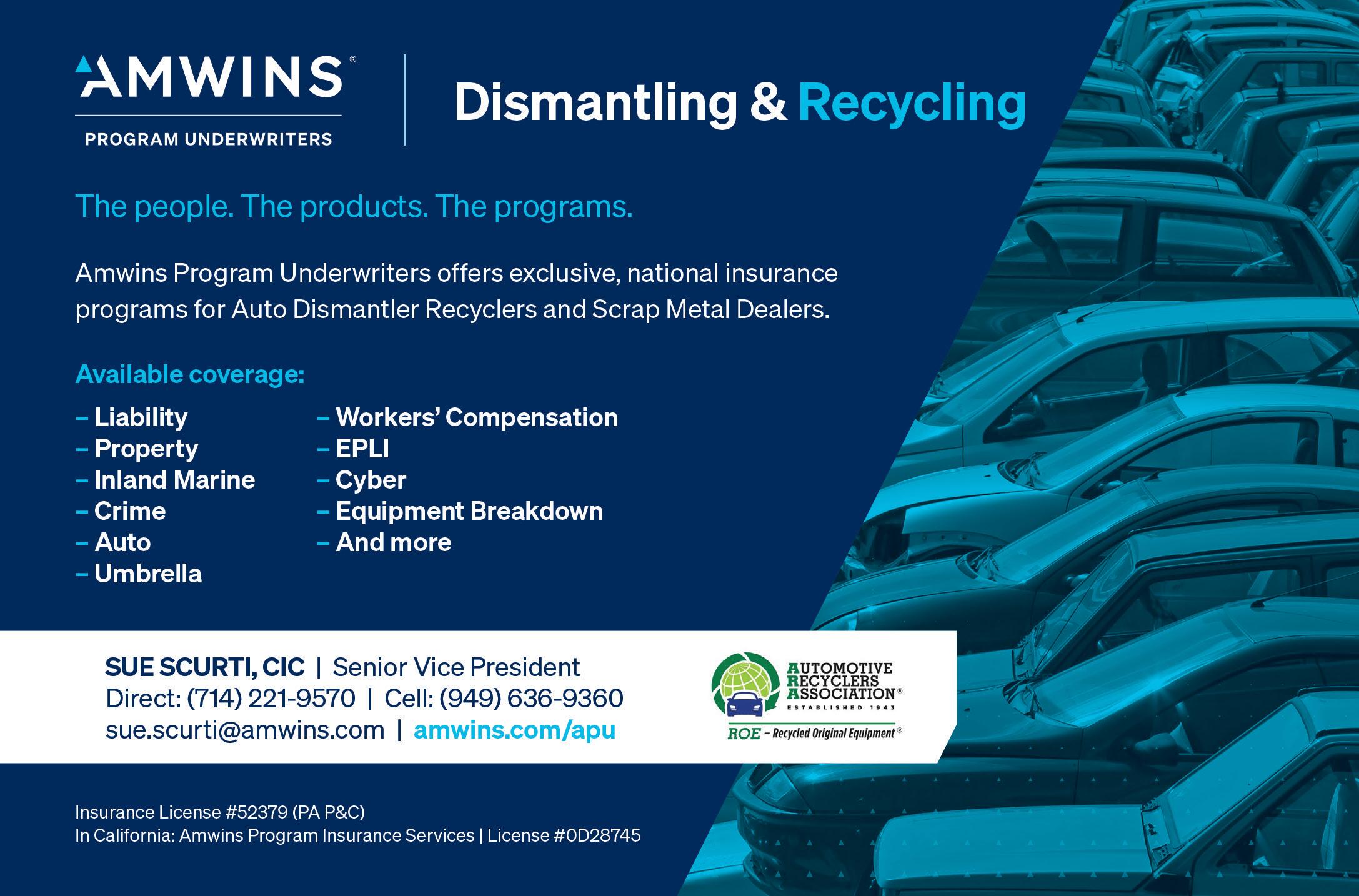




ecycling catalytic converters has become a significant industry due to the valuable metals they contain, such as palladium and rhodium. These metals are crucial for various applications, including automotive catalysts, and their prices significantly impact the recycling market. Understanding the current price environment and market trends is essential for stakeholders involved in recycling catalytic converters.
CURRENT PRICE ENVIRONMENT The prices of palladium and rhodium have seen considerable fluctuations over the past few years. Currently, we are experiencing a market where these prices have somewhat stabilized compared to the exceptional highs seen during the past few years. This stabilization impacts recycling behaviors as collectors and recyclers adjust their strategies to align with the new market conditions.
HOARDING AND MARKET EXPECTATIONS One notable trend in the catalytic converter recycling market is the phenomenon of hoarding. Collectors have been holding onto their materials, expecting better prices in the future. However, with the

recent stabilization of prices, there has been a shift. Collectors now realize that waiting for a return to the exceptionally high prices of the past may not be feasible. As a result, many are beginning to monetize their hoarded materials, contributing to the current recycling rates.
EXCEPTIONAL TIMES AND NEW NORMAL The last few years have been marked by extraordinary circumstances that have significantly impacted the market. The COVID-19 crisis, the global chip shortage, and sustained deficits in palladium and rhodium have all played a role in creating an exceptional market environment. During this period, prices for palladium and rhodium reached unprecedented levels. However, as we move into a new normal, these prices are unlikely to return to their peak levels anytime soon. This realization is driving changes in collector behavior and recycling rates.
SHIFTS IN COLLECTOR BEHAVIOR In response to the new market conditions, collectors are adjusting their strategies. Many are putting previously hoarded materials back into the market. This shift is driven by the recognition that waiting for higher prices may not be practical. Additionally, the influx of new auto catalyst scrap is further contributing to recycling activities. Collectors who have been continuously buying and recycling new materials are now also processing older, hoarded materials, increasing overall recycling rates.
BROADER IMPLICATIONS FOR RECYCLING The implications of these changes extend beyond the automotive industry. Other sectors, such as chemical and pharmaceutical industries, also contribute to the recycling landscape. End-of-life scrap from these industries is increasingly being mobilized for recycling. As these broader recycling efforts continue to grow, we can expect positive impacts on both environmental sustainability and economic viability.
THE FUTURE OF CATALYTIC CONVERTER RECYCLING In conclusion, the recycling rates for catalytic converters are influenced by a complex interplay of market prices, collector behaviors, and broader industry trends. The current price environment, marked by stabilization after exceptional highs, is driving changes in how collectors and recyclers approach their materials. By understanding these dynamics, stakeholders can better navigate the market and contribute to more efficient and sustainable recycling practices. TB
For more in-depth articles and exclusive interviews, visit the rest of our blog here: noble6.com/blog

In their tenure spanning nearly a decade at Noble6, Garrett Schwenk has traversed an impactful journey from a Marketing Coordinator to their current role as Business Operations Manager. With a rich history within the company, theyʼve honed their skills and expertise, initially delving into the intricacies of marketing before transitioning seamlessly into a broader operational role. Garrett brings a wealth of experience, leveraging their foundational marketing background to orchestrate streamlined operations, drive efficiency, and foster the companyʼs growth and success.


n November, we the people of the United States will vote for the next leader of our free nation. Many argue that neither choice for America’s succeeding president is the best candidate. Given that information, as we reflect upon the past, and ponder the potential prosperous or perilous predicaments we might soon find ourselves in, it is imperative that we define what leadership is and what makes an effective leader.
We may not all feel that the hopeful presidential nominees are the greatest choices but we do have the right to vote however we wish. As auto recyclers, we have the freedom to choose and create our own leaders within our industry and businesses. Instead of looking to the president elects to lead us, we must elect ourselves to continue to lead the way and to make things happen. Bi-partisan efforts and working with legislators will continue, yet we must translate leadership on our own level to efficiently move forward towards achieving shared goals and creating a successful future.
Psychologist and author of , W.C.H. Prentice, defines leadership as, “the accomplishment of a goal through the direction of human assistants. A successful leader is one who can understand people’s motivation and enlist employee participation in a way that marries individual needs and interests to the group’s purpose.” Notice that this definition lists nothing of power or popularity. Prentice published this piece in 1961



Creating solid leaders within your business can lead you on the path to success.
“We find ourselves in a season of uncertainty and secular upheaval. A moment in time where long standing beliefs, structures, and institutions of a prior era give way to a new organizing system.”

yet its principles continue to prevail. Leaders can be anyone. Not just bosses, managers or foremen. Being a leader is a choice. Certain people are born to lead, whereas others learn to make that choice to herd others to shared outcomes or destinations. Being an effective leader is determined by how you act and react given the challenges of those you lead and that of the goal to be met.
Given Prentice’s definition, how does leadership translate in the auto recycling arena? What are the intangibles of an effective leader in our industry or in your business? And how do we choose to lead the way instead of following or being misled?
Leadership is a goal we all strive to ascertain. To empower those we need in our business to get the job done right. In order to create leadership we must make the choice to become a leader ourselves. Regardless of one’s job title, we must buy into the goal we are trying to achieve and figure how to make believers of everyone else. A manager can manage and a foreman can supervise, but what makes a person a leader is not how they manage or supervise but through how they motivate.
Besides money and time off there are other means of incentivizing. Figuring out what motivates each person correlates directly with the “why” and




“what” that they are buying into. How you get your employees, co-workers and peers to buy into the cause is just as important as keeping them motivated throughout the process. Our effective leaders show and even personify why and how we are to inventory an agreed amount of vehicles a day, dismantle a set amount of cars a month, sell a predetermined amount of parts a quarter, or make an aspired total of sales each year. The business makes money, you make money. Reach the goal and be rewarded, however without consequences motivation can become a challenge. Our leaders should know how to constructively and conservatively incentivize each member of the team. Knowing how the staff responds to challenges and how each member of the staff is motivated to perform at an optimal level, are the fundamental factors that put leaders on a ballot of their own.
A leader in your business should be able to read the room. To know who is the fastest dismantler, and who is most
BEING AN EFFECTIVE LEADER IS DETERMINED BY HOW YOU ACT AND REACT GIVEN THE CHALLENGES OF THOSE YOU LEAD AND THAT OF THE GOAL TO BE MET.
thorough in their de-pollution jobs. To understand who is likely to cut corners, and who needs the most supervision. Who you can lean on when people call out and who will be calling out. A leader analyzes the strengths and weaknesses of each member of the team, and figures out how to direct each member to achieve the most efficient and productive outcome. Their essential qualities include honesty, integrity, accountability, visionary, reliability, trustworthiness and problem solving. Leadership is living in the complicated, finding creative yet conservative solutions to the cogs within the operations, all while continuing to progress. One who
effectively leads understands intrinsically both the goal and their team. These crucial aspects give us the tools we need to overcome different challenges and navigate unforeseen variables that arise in the day to day. Our leaders know how to approach each member of the team and know that each employee is unlike another and should be addressed and motivated in that way. Positive reinforcement may work well with one coworker but can be seen as just empty words to another. Constructive criticism to one employee may get great results where another employee may take it the wrong way and become less productive or even feel alienated.

It is all about perception. Our leaders must be able to align themselves with the team and exemplify that the playing field is level, respect is earned and given, and through unity and clearly expressed expectations and motivating incentives, we can all succeed.
Leadership in our industry is paramount to getting us to where it is we aim to go. The goals of our business and the recyclers associations may differ on certain levels of operations but the overall shared vision is what we all buy into. For that we look to the members who are leading the way through profitable and innovative processes and procedures. Earned and learned experiences of individuals within the associations allow them the opportunity to make the choice to take on a greater leadership role. We are so fortunate that our industry has a national association, the ARA, that is in step with all that we do. An organization that consistently lobbies for us, the recyclers, and our
shared vision of compliance, Gold Seal standards, and fair regulations and trade, in which to sell our parts within. ARA does all of this while continuing to educate, and lead its members with seeking constant member feedback and input. With the leaders within our state associations, we garner and groom leadership that have different experiences and expertise. Through these shared and different styles and skills, we lead the way through bringing along any and every of our fellow recyclers. We give each other the tools needed to reach our individual outcomes, while working together to move forward in a direction of success and progress as an association.
Election day is just months away but the time is and will always be now, to make the choice. To decide whether to lead or to be led. Take control of your business, realize your potential and empower yourself and all those around you to make that same decision. Do not
bank on the promises of any presidential candidate. We mustn’t allow ourselves to be misled, for the success of our future resides in our calloused and oil stained hands.
To quote ARA Past President Mike Swift, “If not you, then who?” Elect yourself and encourage fellow leaders in your business and in our industry to continue to rise up. Vote to marry your interests and needs with those of your team, and begin to motivate each unique individual along the path to these shared goals that we will create. Through our hard work, solemn resolve and persistence, we will weather this November and move through this perceived Fourth Turning. To reach this high, as always the auto recycler will need to stay relevant, resilient and relentless in our pursuit of perpetual prosperity. May our parts and practices propel us into tomorrow while our leadership leverages our lasting longevity. TB




From continuous learning to emptying the garbage bins, being a solid leader takes many forms.
ell, it’s that dreaded time of year again. The leaves are changing. The temperature is getting cooler, and the daylight is getting to be a little less every day. You might be tempted to think I’m talking about winter coming, but I am, in fact, bemoaning the season of election time, when we select our leaders.
Now don’t get me wrong, I greatly appreciate the right to vote. There is a lot of gratitude in my heart when I think of those that sacrificed so much to give us that privilege. The problem for me then is not that I “have” to go vote, but centers more around the quality of the available candidates, or lack thereof.
Sometimes it feels like if the elected official would do half of what they said they would, we would all be far better off. They promised only good things such as lower taxes and fighting for our freedom, etc. but alas, at the local, state, and national level seldom do we see our taxes lowered or our freedoms protected. Is this good leadership? I’ll let you be the judge of that as, like most things, this is largely subjective to one’s opinion. Leadership is important. I do know that there are many in the auto recycling community that serve their communities not only in a political capacity, but on school boards, church councils, civic organizations, and charitable foundations.
Auto recyclers are, for the most part, natural leaders in

whatever they do. That is why we are in the position we are in to start with. The auto recycler is usually a resourceful, and imaginative forward thinker and leader. We see a problem that needs solving and we do it – some more than others. We are not all made the same. Truth be told, I do not consider myself to be some cape-wearing super-owner. I’m not even a natural born leader. I’m not extremely charismatic, and I did not get into this industry because I had some grand dream. I kind of backed into it, but I am a leader in the business, none the less.
Since none of this comes naturally to me, I have had to learn what a good leader does. Here is a list of some of the key things I have picked up over the years that have helped me and will hopefully help you too.
#1: I HAVE NOT LEARNED ENOUGH. I am not there. I am not the world’s greatest boss. I need to improve myself and hold myself to a higher expectation. I must continue to grow. Reading and attending seminars are a great way to do this.
On that note, I urge everyone that can make it to the conventions and join me in learning more about this and a myriad of other topics related to the industry. If you have a book that has helped you, reach out to me with recommendations. I am always looking for something to read.
#2: I HAVE LEARNED TO BE THE FIRST ONE TO THE OFFICE. Years ago, someone shared with me the wisdom of being the
Jake Nawrocki, with sister Katy Joles, own and operate Rocki Top Auto Recyclers in Glen Flora, Wisconsin. The company was formed in 1988, and Jake and Katy took over operations in 2009. Since that time, they have been working both in and on the company, in a region that is economically challenged.
“Our goal is to make Rocki Top Auto a destination.” Contact Jake at 715-322-5774 or rockitopauto.com.
first one to work, and the last one to leave. When we do this a couple things happen. One is optics. When the team sees us at work when they arrive and sees us still working when they leave to go home for the day, they can’t help but know we care about our business. This inspires confidence and a willingness to buy in to our philosophy.
It doesn’t have to be anything elaborate. My early morning time consists of taking care of messages that need to be replied to, drinking coffee and meditating before the day gets hectic, and sometimes working on removing broken exhaust manifold bolts. For some reason, I really enjoy doing that and we don’t want any engine to leave our facility with broken bolts hanging out. At the end of the day, taking a little time to empty trash cans, sweep, or clean bathrooms is a nice way to be busy while your employees are winding down and heading out. It needs to be done anyway, and for most, it is meaningful to see the boss doing that. It is also therapeutic. It feels good to clean.
#3: LEADERSHIP IS ONE HUNDRED PERCENT NOT ABOUT US, BUT ABOUT THE ONES WE LEAD. To be an effective leader, we must have our team behind us in likeness of mind, but more importantly we need to know what they need and want and do our best to make that happen. As Joe Gibbs said, “To reach your own goals and dreams, you must learn how to assist others in reaching theirs.” This is not always easy of course, but nothing worthwhile is. Every individual on the team is a little different, they have different life situations, dreams, and desires. If we are able to put on enough humility to get to know the things that our people need to get the most out of life while they are part of our work families, it benefits every single team member.
So, as we head to the polling places to select our leaders, let’s all take a moment to thank God for our freedom to do so, and then take a moment to reflect on our own roles as leaders in our workplace, our communities, and homes.
Keep up the excellent work of making our industry one of the best to be in! TB




















Understand healthy competition and why it can help your business get ahead.


had an exceptionally good reason that I did not understand at the time.
The vendor understood a huge marketing principle: Competition next to each other increases the response rate for each of them substantially. Although this concept may seem illogical, even crazy, many studies have confirmed its accuracy, such as the soda machine experiment described below.
A Coke machine, situated in a prime location with high foot traffic, sold approximately 100 sodas daily. After a while, they placed a Pepsi machine right next to it. Now, you would logically assume that the two competing brands





the different question psychologically formed in their minds. This powerful marketing concept is why you see so many fast-food restaurants together rather than choosing to be far apart from each other. McDonald’s, Burger King, Taco Bell, and many others build next to each other on purpose because they all do better together. And many other like-kind businesses, like car dealerships, clothing stores, and hotels are deliberately near each other. This is also why trade shows do so well, with so many competitors selling similar products there.
So, now that you know that competitors near each other generate an exponentially larger response than being
alone, how do you stand out in that crowd to make actual sales? Let me explain.
During my first days in the advertising industry, I took part in many marketing conferences and seminars to hone my skills in direct response marketing. I learned the most useful stuff from marketing guru Dan Kennedy, author of , and many other how-to books on the subject. His marketing methods have made millions for many top Fortune 500 companies. At one of his seminars, someone asked him, “How do you stand out from a crowd of competitors when they are all advertising on the same pages next to each other, such as in a newspaper or magazine, and when they are all going for the same customers, especially when they are among your most steadfast rivals?” Kennedy said he followed seven basic rules that forced people to notice his ads first every time, over all the others, especially when among competitors. Here they are:




1. PLACE A POWERFUL HEADLINE AT TOP. The biggest mistake most advertisers make is placing their company’s name or logo at the top of their ad. This is what most of your competitors do. They do not generate sales. Fixing this will, at once, make your ads more powerful than theirs. Place your name and logo at the bottom of your ad and make them small; if your ad is powerful enough, people will squint to find them.
Mike French is retired after 39 years of business in the automotive recycling industry. He is an author, publisher, consultant, and speaker. Mike is the founder and executive director of the Christian Auto Recyclers and Vendors Association (CARVA) and will be at upcoming recycler trade shows and events. Mike is available to speak at your group, conference, or event. He loves to share inspirational stories that demonstrate how the Word of God actively changes lives. He can be reached at mike@carva.group. Visit www.CARVA.group and/or www.PowerPackedPromises.com.





Use the space at the top of your ad for a powerful response-pulling headline that answers your customer’s most important self-centered question, “What’s in it for me?” For recycler ads, one headline I have used is, “Save 40 to 60 percent off the price of buying new with our top-quality OEM recycled parts!”
2. SHOW ATTRACTIVE PHOTOS OF YOUR BEAUTIFUL PRODUCTS TO CATCH THEIR EYE. I always showed great photos of engines, trannies, doors, and wheels, which are the parts many are looking for.
3. INCLUDE AN IRRESISTIBLE OFFER, ONE THAT IS IMPOSSIBLE TO REFUSE. Such as, “Mention this ad and receive an extra 10% off your order and get free delivery to your door!”
4. PROVIDE VALUABLE MONEYSAVING COUPONS WITH A DASHED LINE AROUND THEM AND A SCISSORS ICON. Include an expiration date to create a sense of urgency. Coupons have the same value as money in their
COMPETITION NEXT TO EACH OTHER INCREASES THE RESPONSE RATE FOR EACH OF THEM SUBSTANTIALLY.
hands, making your ad a keeper. This is particularly helpful in direct mail flyers, where most people sort their mail over the trash.
5. INCLUDE AN IRONCLAD GUARANTEE. This will take care of the fear of buying. This is especially true with used auto parts. Something like, “100% satisfaction, or your money back.” By the way, if you can’t say this about your parts and service, go find something else to sell.
6. HAVE A STRONG CALL TO ACTION. Tell them what to do, how to place an order, and to do it now.
7. AD PLACEMENT IS VERY IMPORTANT. Remember that people read from left to right and from top to bottom. And
as they read, their eyes go from top left and wander down the page at a steady slant and end up looking at the lower right corner. Therefore, when you order an ad, ask for the top left corner or bottom right corner of a single page. No one sees the top right or lower left corners on the page. And if your ad is in a magazine, request it be on the right-hand page. When people turn magazine pages, they always look at the right-hand page fi rst.
Do not be afraid of your competitors but involve them enthusiastically. It has excellent potential to help you get further ahead, especially if you make your ads stand out among from them. TB



From leadership classes to mini sales meetings, a mini-thumb drive is teeming with learning opportunities and inspirational content.
ave you ever had your spouse nag you to clean out that office, warehouse or garage, but for some reason you put it off until you need something found? Such was the case recently. I had been putting together materials so that I could speak in Mississippi to a group of independent auto dealers. Since I had not spoken to any group for the past few years, I thought it prudent to explain to the executive director that I was diagnosed with Guillain-Barre in December. After over-hearing my conversation with that director, my wife presented me with four cases of books from my office. She asked, “Can you sell them while you’re in Mississippi? It sure could help pay some medical bills.” So, folks, here’s my offer. I’ll give you a FREE copy of that book,
, PLUS a FREE copy of the book, now over 500,000 in print. Here’s the offer. I’ll give you both books FREE, IF you’ll buy a thumb drive fi lled with 3½ hours’ worth of my training. Included on this thumb drive are: “Time,” which is about God giving us 86,400 seconds each day. It’s amazing how some of us spend those 86,400 seconds that we have daily. How do you spend yours? This short video is very thought-provoking and lasts about six minutes in length and was produced by Disney.
Then there’s the “Dash” poem, written by Linda Ellis, the famous writer but performed my me in a cemetery. A dash between the years shows the date of when a person is born and the date
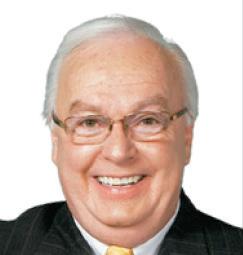



when a person has died. What’s to be remembered is the dash, all the years and events of the person’s life between birth and death. It’s not about the car, house or cash, but is how you lived your “dash” and how you’ll be remembered. Added to this thumb drive are over 28 mini sales meetings which run about three minutes in length each. A good suggestion here, you can plan to play one at the start of your meeting, and one at the end. All those meetings are done by me and are full of good business information. The thumb drive also includes the “Eye Can.” Even the last four letters of the word, American, has “i can” in it. It makes everyone listening to it leave with an “I CAN” attitude.
Also, on this thumb drive are four leadership classes which are perfect for anyone who you might be molding into a future manager. A big piece of this is phone training from the person answering the phone to the salesperson using customer care. Yes, even which ear you
use has a bearing on the outcome of a call.
Now, let me tell you about “Words to Live By” on this thumb drive. That training focuses on an all-day meeting. It’s not focusing on just a few people within the company but everyone who works for a company. It was broken down into two sessions which allowed any owner to bring in food and soft drinks. Here I am revealing what happened one day during this training at a company. A frustrated man on the verge of losing his cool walked over and asked, “When will this blankety-blank meeting be over?” A little taken back, I quickly responded, “In about 55 minutes.” Without hesitation, he retorted, “It better be. I don’t have time for this feel-good crap.”
It takes about six to seven minutes to hear that segment.
My producer, Bob Chesney, a voice and recording professional from Los Angeles, California, does recordings for
D.J. Harrington is the President and Chief Executive Officer of Phone Logic, Inc., an international training company based in Atlanta, GA. He serves as a consultant and trainer to over 1,000 privately-owned businesses throughout the country, training personnel at all levels of the company, from the dispatcher to the customer service and sales staff. Please visit his website for more information at www.djsays.com.

Tony Robbins too. Bob literally works for some heavy-hitting speakers. When I had finished with my training that day, I picked up all my props and headed to my rental car. As I approached my car, standing next to it was the same man who asked how much longer I was going to speak. Not really looking forward to what he was going to say this time, the man revealed that his 16-year-old daughter had left home only eight weeks ago and was living with another family about four streets away. She wasn’t coming back because of what he had said to his daughter. No, I didn’t sell him a copy of “Words to Live By” that day. After hearing his plight, I literally gave him a copy of it because I felt sorry for him and his wife. Three weeks later, the owner said that
Itʼs amazing how some of us spend those 86,400 seconds that we have daily.
How do you spend yours?
man had the most improved attitude on his team. He had dropped the copy I had given him into the mailbox for his daughter. Four days later when he came home from work, his daughter was there crying at the kitchen table with his wife. She wanted to come home. Folks, that’s one reason why I love, “Words to Live By”.
The entire 3½ hours of the thumb drive is fi lled with wonderful stuff that helps employees and their relationships. Also, included on this thumb drive is what I delivered for the PGA and the professional golf association. Just a few years back, I gave all their members a copy of “Words to Live By.” Here’s how they use it. They play it before they interview new team members. If prospective interviewees like what they see in this training, then they get hired because they know they will be faithful team members. Since it’s worked for the PGA, it can work for you and your business, too.
Folks, the whole package is $50. That includes the thumb drive with all the training, plus books. All you must do is send me a text message with your contact information, and I’ll pay shipping and handling. I’ll include an invoice with your package. After receiving shipment, if you feel all of this isn’t worth $50, just send everything back to me. No questions asked. This will help me get rid of some books and lower my medical bills. So, it is a “win-win” for both of us. Getting your order processed is easy. Email your contact information to: dj@djsays.com, or you can text me your request and contact information to: 770-301-4122.
See you on the next podcast. TB


Due diligence in LTL shipping can go a long way in customer service and bottom line success.
grew up in the salvage business and spent 25 years working for building material manufacturers. Customer service and relationships were always emphasized. My grandfather and father aimed to build a salvage business that customers would return to, and the same principle applied to building materials, where relationships were paramount.
When I entered the shipping business in April 2020, I quickly realized that the shipping industry moves too fast for carriers to prioritize customer service. They view your shipment as just another box/pallet/pail/bundle/carton/tote/ drum, etc., moving from point A to point B. As a result, it’s crucial to protect yourself when shipping LTL. Here are three ways to do so:
Our business has shipped several thousand LTL shipments over the last few years. One of the biggest mistakes we see is shippers who do not adequately protect their shipments. Ask yourself these questions when assembling your package/pallet:
1. Will the part stay on the pallet?
2. Is my pallet strong enough to withstand the journey?
3. If something falls on my shipment, is it protected?
To get more information on packaging, I recommend Googling “Packaging requirements for LTL freight.” Many carriers provide excellent resources on how to secure your freight for LTL shipping.
Insurance is a necessity, especially when shipping used parts. Before entering the shipping business, I scoffed at the idea of buying shipping insurance. Now, I wouldn’t ship anything of value (usually over a few hundred dollars) without it. My first experience involved a used motor that

Tony Jenkins grew up in the salvage business (Birmingham Auto Parks, Birmingham, MO) and his family still owns a salvage yard in Kansas City. After spending 25 years in corporate America, in 2020 Jenkins started InXpress 308. Today, the majority of the business for InXpress 308 is with salvage dealers and other related industries. InXpress 308 is the only place where you can ship blinker fluid, flux capacitors, and muffler bearings for free. To learn more about Jenkins and his background, visit https://www.linkedin.com/in/asjenkins..


was dropped by the carrier, cracking the block. Without insurance, the yard received only $35 on a $3000 motor after eight months of negotiation. Carriers typically reimburse at ten cents per pound for used parts. Insurance can cover shipments valued under $5000 for around $30 with no deductible, making it a worthwhile investment.
Beyond packaging and insurance, protecting yourself means thoroughly documenting your shipments. This documentation should include:
1. Photos of the part being shipped
2. Photos of the part on/in the pallet/container
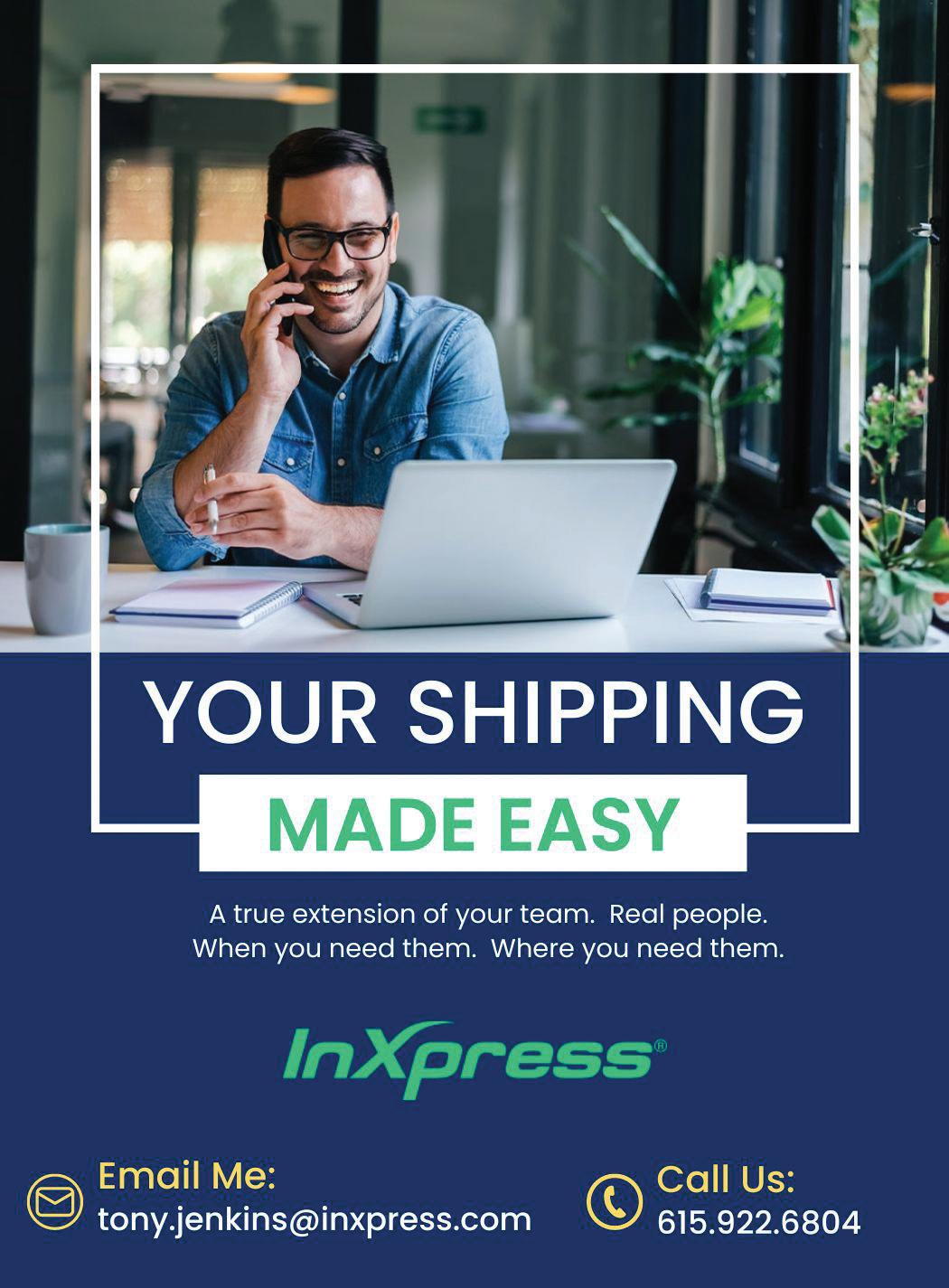




While carriers may not prioritize customer service, you can protect yourself by packaging effectively, taking insurance, and documenting everything.
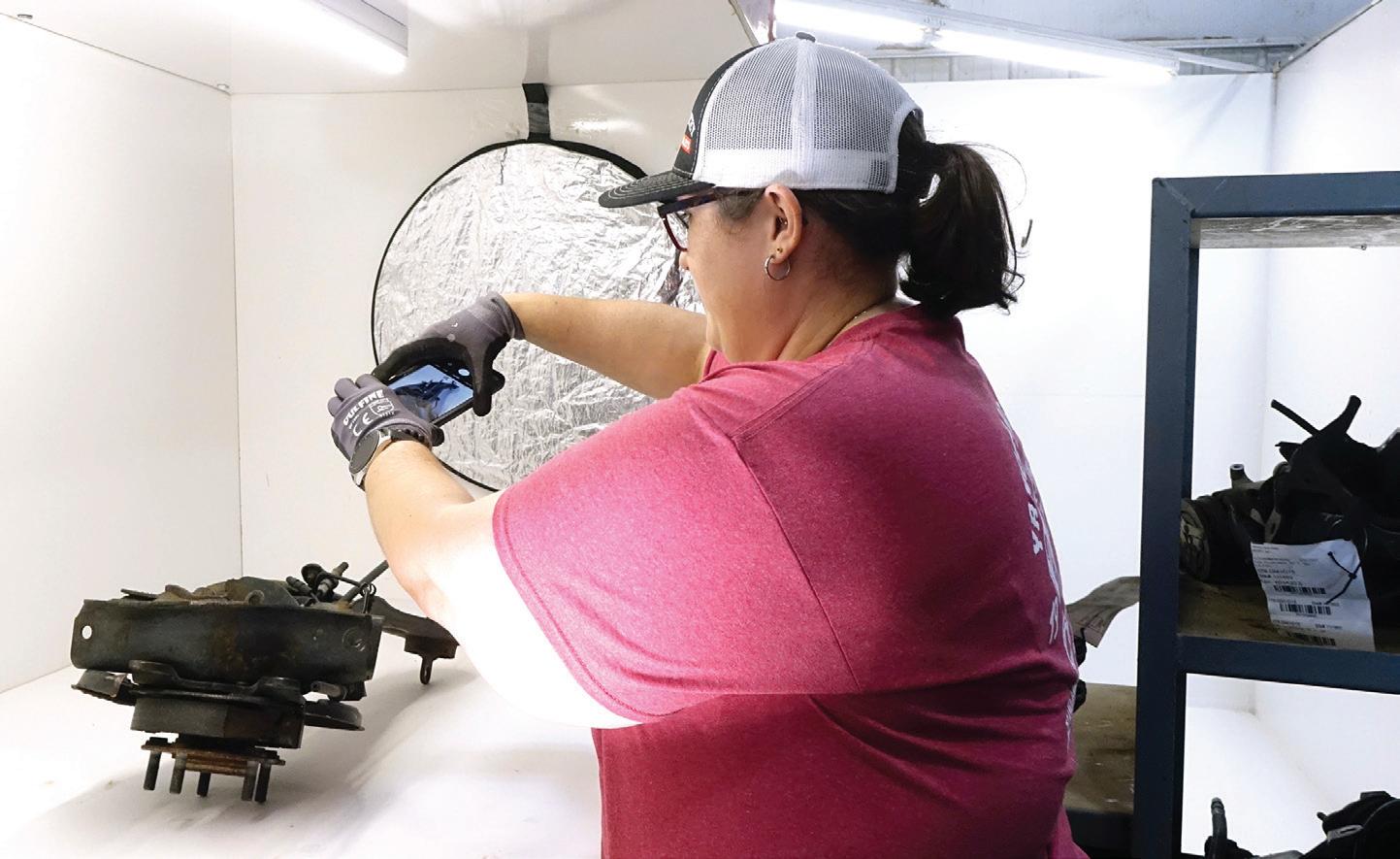
3. Photos with a measuring tape showing all dimensions (LxWxH)
4. Photos of the shipment on a scale
Documenting your shipment can prevent and resolve issues with carriers. For instance, we had a 250-pound transmission shipment incorrectly billed as 5000 pounds. Resolving this
required extensive documentation and persistence, as carriers prioritize their protection over yours.
While carriers may not prioritize customer service, you can protect yourself by packaging effectively, taking insurance, and documenting everything. These steps ensure
your shipments are secure, properly insured, and well-documented, safeguarding your business against potential losses in the LTL shipping process. Remember, carriers are focused on their protection; you need to focus on yours. TB






Among the automotive recycling industry are dedicated professional women who make significant contributions to the success of the business.
Kelly Reopke grew up in south central Illinois with her three sisters, attending dance classes and riding dirt bikes. Kellyʼs parents, (Mike and Kathy Nolan), started Y-Yard Auto Parts and welcomed the girls into the business and so many of their weekends were touring around the countryside submitting salvage bids and purchasing vehicles. On weekends, Kelly remembers waking up early to attend auctions with her father and before she could get her license, she had to perform her dadʼs dismantling test in case she were to get stranded or have to chain her tire someday. During her holiday breaks, she helped her father deliver parts and haul the vehicles home from the auctions. Kelly delivered parts, dismantled vehicles, worked in maintenance and even assisted in the office where needed, thereby learning every aspect of the recycling business.
During high school, Kelly worked summers at her familyʼs company and continued working during summers whilst attending Illinois State University (ISU). She graduated from ISU with a Bachelorʼs degree in Education and landed a job as a first grade teacher in her home town. Three
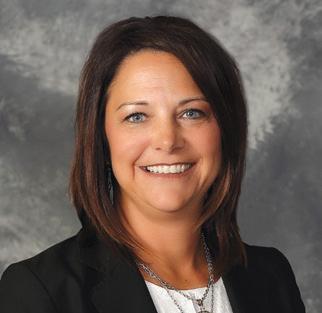
Kelly Roepke President, Y-Yard Auto & Truck Parts Effingham, Illinois
years later, Kelly decided to resign from her teacher position and join Y-Yard while her dad underwent extensive back surgery. Just after one year of working at the company, she decided to make a full-time career in automotive recycling.
As the automotive industry continues to evolve, Kelly has realized that finding, hiring and training employees is a common struggle amongst auto recyclers and would like to utilize her experience in helping the board in those areas. She hopes that she can bring some of her educational skills to the table as a URG board member and benefit the training program and its members.
“I am passionate about education and training. In todayʼs world, the struggle of finding quality employees is real. When we do find them, we need to make sure that we do our part in educating and training them
on how to do the job properly,” explained Roepke.
“More importantly, finding consistency throughout the industry and together with our members we can be stronger and more consistent in what we sell and deliver to the customer, which makes our industry more powerful.”
Currently, she serves on the Curriculum Committee for the Effingham Regional Career Academy where she works with students interested in going into the automotive trades. Kelly was also on the Board of Directors for Crossroads Bank. In 2008, she was recognized by fellow auto recyclers as “the Most Influential Successorʼ and the “Most Influential Woman” and has served on many other auto recycling boards.
Today, Kelly serves as the President of Y-Yard in Effingham and is celebrating 25 years with the company, along with her husband, Kevin, and their two children, daughter (Karlee) and son (Connor). Karlee will be graduating from the University of Alabama this year and Connor is playing baseball for Southwestern Illinois College.
For more information on Y-Yard, please visit www.y-yard.com or call 1-800-252-4040 or contact Kelly at autoparts@y-yard.com.




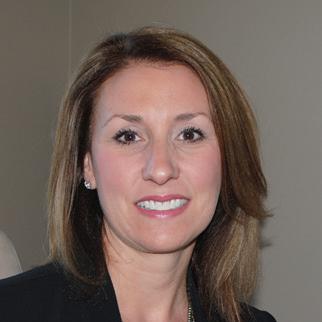
NNatalie Miller
Owner, Millerʼs Auto Recycling Ontario, Canada
atalie is a third-generation family business owner of Millerʼs Auto Recycling, which was founded in 1953 by her grandfather. After one brief summer working at Millerʼs during high school, she chose to pursue a career outside of the family business and then graduated from DʼYouville College in Buffalo, NY with a Bachelor of Science degree in physician assistant studies. For the next six years, she was a physician assistant at Excelsior Orthopedics in Amherst, NY which she said was “incredibly challenging and fulfilling.”
In 2009, Natalie made the decision to return to the family business, which was very challenging with all the changes going on in the industry. She held various
positions from human resources, finance, marketing and strategic planning. She notes that it has been a rewarding work environment with their core business auto recycling which includes used parts sales and end-of-life vehicle recycling.
Natalie resides in Fort Erie, Ontario with her husband and their daughter, Sophia and son, Brayden. Natalie is serving as Director of the Ontario Auto Recyclers Association (OARA), Committee Chair for the Educational Programming for ARA and recently completed her term as the Canadian Representative on the ARA Board of Directors. For more information on Natalie or Millerʼs Auto, please visit millersauto.com or email natalie.miller@ millersauto.com.

Rachel Whestone Ehlers Co-Owner, Allied Auto Salvage and Pull-N-Save Riverside, California
Rachelʼs diverse background as a late model auto recycler in Minnesota and a high-volume auto recycler in California gives her a unique perspective of the industry. Rachel is a seasoned and passionate speaker and she believes that enthusiasm is contagious and has the power to shape the future of our industry. Rachel has demonstrated collaborative leadership in her roles for the United Recyclers Group (URG) board of managers, PRP Executive Board, PRP West Chairperson, and Automotive Recyclers Association of Minnesota (ARAM). Rachel is a co-founder of SmartCycle a business intelligence software focused on helping auto recyclers.

Rachel and her husband split their time between California and Wyoming. Rachel enjoys spending time with family, growing her business, golfing, and traveling. She is especially excited that her oldest daughter is showing interest in being a fourth-generation auto recycler.
“It is true that my exposure to the industry started with family ties, but I have never been held back or had to prove myself to my colleagues because my success has been built on hard work and collaboration,” explains Rachel. “The expectations that I set for myself, and others, are not based on gender or family roles. We are truly only limited by our mindset and willingness to do the work. I encourage everyone in our industry to pull their seat up to the table where our industry is influenced, and great innovation is born. The American Dream is still alive and well in our great industry.”

FFran Reitman
Owner, Reitman Auto Parts & Sales, Inc Melbourne, Kentucky
ran has been a member of ARA for over 42 years and served on the board of directors and many committees for ARA. One of her most memorable events was in 2009, when she was a chairperson on the ARA University Committee running a “horse-raced theme” for the annual convention in Lexington, KY. The event brought in more than $85,000 for the university website safety training program. Fran has also served as President of the Kentucky Auto and Truck Association, helping improve the “end of life” process for automobiles. She has also traveled the world helping others in the industry understand the importance of safety
training in the industry. Currently, Fran is serving on the Automotive Recycling Training Institute Board and the ARA Scholarship Foundation, and she also serves on the Certification committee which supports the Randy Reitman CAR award, and worked along her husband, Randy, and side-by-side with her sons, Nick and Adam (4th generation).
“ARA has given me the privilege of working with and alongside some of the most passionate women and men in this wonderful industry,” Reitman says.
For more information on Fran or Reitman Auto Parts please visit reitmanautoparts.com or email fran@reitmanautoparts.com. TB
LARA – Ladies of the Automotive Recyclers Association seeks to promote automotive recycling as a career choice to women and open pathways to enter and thrive in a fulling career within this business community. LARA also provides networking and educational events, usually held at the annual convention of the ARA. If you interested in participating, contact staff@a-r-a.org to find out more on LARA.




California SB 615 (Vehicle Traction Batteries):
After having been introduced in the California State Senate in February 2023, California Senate Bill 615 (SB 615) recently passed the Legislature and is awaiting a decision by Governor Newsom. SB 615 is the most significant piece of legislation governing the entire lifecycle of vehicle traction batteries. SB 615 was drafted and introduced as a bill after Californiaʼs Lithium-ion Car Battery Recycling Advisory Group issued its final report and policy recommendations in 2022. While not an appointed member of the Advisory Group, ARA was able to represent the automotive recycling industry throughout the three years that the group held meetings. In 2020, ARA was invited to give a presentation to the Advisory Group and ARA was asked to provide substantial feedback to the Advisory Group, which was incorporated into the Advisory Groupʼs final report. The work done by ARA with the Advisory Group had a strong impact on ARAʼs ability to represent the industry during the development of SB 615.
SB 615 will serve as a basis for additional policymaking dealing with vehicle traction batteries in the future. Throughout the two years SB 615 was working its way through the California Legislature, ARA and CADRA worked with Senator Allenʼs staff on finetuning the language to protect the ability for automotive recyclers to put vehicle traction batteries to their highest and best use. Provisions that ultimately were included in the final bill were as follows:
1) Inclusion of Battery Materials Use Hierarchy that prioritizes the reuse, repair, repurposing, and remanufacture of batteries (in that order) prior to the battery needing to be recycled;
2) Allows automotive recyclers to maintain existing business practices and engage in commerce in batteries without being classified as a battery supplier;
3) Obligates battery suppliers to make battery state of health data easily accessible to automotive recyclers and second life
companies (both while the battery is inside the vehicle or outside the vehicle);
4) Requires battery suppliers to cover the costs associated with collecting and processing negative value batteries;
5) Includes recordkeeping requirements on battery transactions;
6) Defines qualified battery recycling facilities in a way that does not give one type of battery recycler a clear competitive advantage.
ARA was invited by the Argonne National Laboratory to give a presentation at this yearʼs ReCell Industry Collaboration Day. The ReCell Center is a Department of Energy funded research and development center whose purpose is to help enable the United States compete in a global recycling industry and reduce reliance on foreign sources of battery materials. ARAʼs presentation focused on progress ARA and its members have made over the past year relating to the acquisition, storage, and handling of EVs and PHEVs. It also highlighted the challenges facing automotive recyclers when acquiring EVs and PHEVs. ARAʼs presentation was well received and has created further opportunities to assist the industry in improving its strategic position.
In addition to making a presentation at the ReCell Industry Collaboration Day event, ARA participated in a Li-Bridge meeting that focused on the tracking and tracing of batteries and battery materials. During this meeting, industry came together to share ideas and develop policy. ARA participated in the daylong event and recommended that the following data points be captured and made accessible to entities within the value chain: (1) dismantling information; (2) safety information; (3) chemistry type; (4) composition; (5) state of health data; (6) repair and maintenance. Final takeaways from the meeting will be included within an upcoming white paper developed by Li-Bridge.
ARA is excited to announce that a Spanish version of the popular Inventory Specialists and Parts Grading module is now available!
This module includes informative examples and dialogue about how to inventory a vehicle and properly grade collision parts, mechanical parts, wheels, seats, cosmetic parts and more.
Updated by ARAʼs Interchange Committee, this is an excellent resource for training your staff on the importance of having consistent grading within the industry and why accurate part descriptions as well as photos are so important.


ARAʼs Vice President of Strategy, Government and Regulatory Affairs, Emil Nusbaum, recently sat down to talk about automotive recycling and electrification on the EVs for Everyone Podcast. Emil joined Elena Ciccotelli, the Producer and Host of the EVs for Everyone Podcast, and Scott Packard, Director of Business Development & Project Leadership at Smartville Inc., to talk about electric vehicles.
During the podcast, Emil, Scott, and Elena talked about necessary market developments that must materialize if electric vehicles are going to comprise a larger percentage of the passenger vehicle market. This includes the need to reuse, repurpose, and remanufacture batteries by using affordable and accurate testing equipment. Emil also discusses the challenges facing automotive recyclers and pending legislation that may change the way that battery electric vehicles are handled at end-of-first-life and end-of-life.
Listen to the podcast here: https:// evs4everyone.com/whats-ev-batteryrecycling-got-to-do-with-it/.
A. TRI-STATE AUTOMOTIVE RECYCLERS SUMMIT & EXPO
B. ARNE CONVENTION & TRADESHOW 2024


The 2024 MIDWEST Summit & Expo, bringing together professionals from Indiana, Kentucky, and Ohio, was held at the Sheraton Indianapolis Hotel at Keystone Crossing from Friday, August 16 to Saturday, August 17, 2024. The event commenced on Friday evening with a welcome reception, offering attendees an informal setting to network and connect with industry peers.
Saturdayʼs program began with a keynote “State of the Industry” address delivered by then ARA Executive Director Sandy Blalock, setting the tone for a day filled with valuable insights and learning opportunities. The schedule was packed with a variety of educational sessions and roundtable discussions, designed to address key issues and trends in the industry. Topics included “Purchasing, Inventorying, and Parts Grading,” which provided attendees with strategies to optimize these critical business processes, and “Keys to Boosting Sales and Making Them Stick,” focusing on sales strategies and customer retention. Additionally, a “Production Round Table” allowed participants to share best practices and challenges in production, while a management training session provided tools and techniques for effective leadership and team management.
The event was highly successful, attracting a robust turnout of over 100 industry professionals. The diverse agenda and interactive format facilitated meaningful exchanges of knowledge and experiences, making the 2024 MIDWEST Summit & Expo a pivotal event for those in the automotive recycling industry.


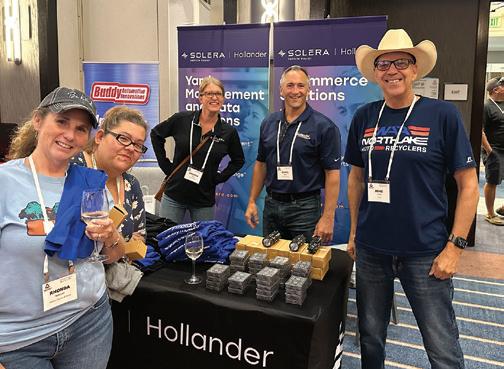

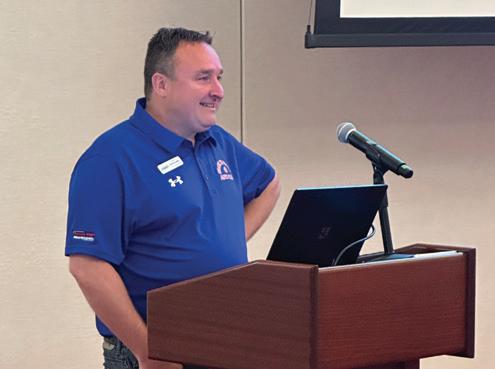
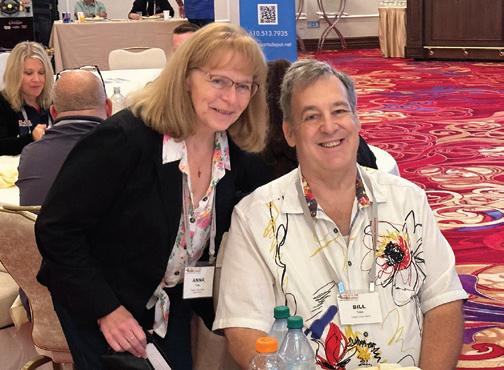


TWEST MIDWEST SOUTH NORTHEAST


We would love to hear your employee, company, and state news: toolbox@a-r-a.org


he ARNE Summit & Expo, held on September 13-14, 2024, at the Turning Stone Resort & Casino in Verona, New York, brought together auto recyclers from the Northeastern U.S. and Canada. The event featured expert speakers addressing key industry trends and issues, along with an Expo showcasing innovative technologies and services to boost recycling operations and profitability.
Attendees participated in various sessions, including discussions on legislative affairs, leadership, trading networks, and community impact. Breakout sessions focused on safety culture, sales professionalism, building customer bases, and quality control metrics. The event also hosted networking opportunities such as a tailgate night, vendor presentations, and a dinner with an auction.
Additionally, the ARANY Autos4Vets program provided a chance for attendees to support veterans in need by donating roadworthy vehicles or making financial contributions for repairs, insurance, and maintenance. The vehicle was awarded to a veteran during the event.
Overall, the venue was great and the summit was well attended and provided valuable insights, networking opportunities, and educational sessions, enhancing the knowledge and connections of participants within the auto recycling industry. TB

IMPORTANT: RENEW YOUR SUBSCRIPTION AT https://autorecyclingnow.com/toolbox/subscribe THIS IS REQUIRED TO CONTINUE RECEIVING THE TOOLBOX!
The Automotive Recycling ToolBox™ Edition delivers peer-to-peer articles with information that you would get while networking at industry events and trade shows. Our mission is to be current, educational and inspirational. We bring you:
• Educational and instructional “how-to” articles written by fellow recyclers, top industry professionals, leaders & trade show speakers.
• Information from providers of industry-related products and service you typically find at industry events and trade shows.
PUBLISHED 6 TIMES A YEAR AutoRecyclingNow.com/Toolbox
AUTOMOTIVE RECYCLERS ASSOCIATION OFFICERS
YOUR TOOLBOX TEAM
Published by Driven By Design LLC
EDITOR
Caryn Smith, Toolbox@a-r-a.org
ART DIRECTOR
Jessie Sharon
ADVERTISING SALES
Jay Mason, ToolboxAds@a-r-a.org
EXECUTIVE DIRECTOR
Vince Edivan
Automotive Recyclers Association Vince@a-r-a.org
SENIOR DIRECTOR OF ASSOCIATE OPERATIONS
Jessica Andrews, Jessica@a-r-a.org
SENIOR DIRECTOR OF MEMBER SERVICES
Kelly Badillo, Kelly@a-r-a.org
VICE PRESIDENT OF STRATEGY AND GOVERNMENT AND REGULATORY AFFAIRS
Emil Nusbaum, Emil@a-r-a.org
PROGRAM MANAGER
Kaitlyn Gatti, Kaitlyn@a-r-a.org
EVENT MANAGER
Kimberly Glasscock (615) 476-4501 kglasscock@awardwinningevents.com
CERTIFICATION CONSULTANT
Sue Schauls, Sue@a-r-a.org (319) 290-7843
PRESIDENT Eric Wilbert Wilbertʼs U-Pull-It, LLC Williamson, NY eric.wilbert@wilberts.com
1ST VICE PRESIDENT Shannon Nordstrom Nordstromʼs Automotive, Inc. Garretson, SD shannon@nordstromsauto.com
2ND VICE PRESIDENT/TREASURER Sean Krause Speedway Auto Parts, Ltd. Joliet, IL sean.krause@speedwayap.com
SECRETARY Tom Andrade Everettʼs Auto Parts Brockton, MA tandrade@everettsautoparts.com
IMMEDIATE PAST PRESIDENT Nick Daurio Daurio Auto Truck Pueblo, CO nick@daurioauto.com
ARA CONTACT INFORMATION
ARA Headquarters Manassas, VA (571) 208-0428 staff@a-r-a.org www.a-r-a.org
To
For editorial contributions, e-mail Toolbox@a-r-a.org or call (239) 225-6137.

